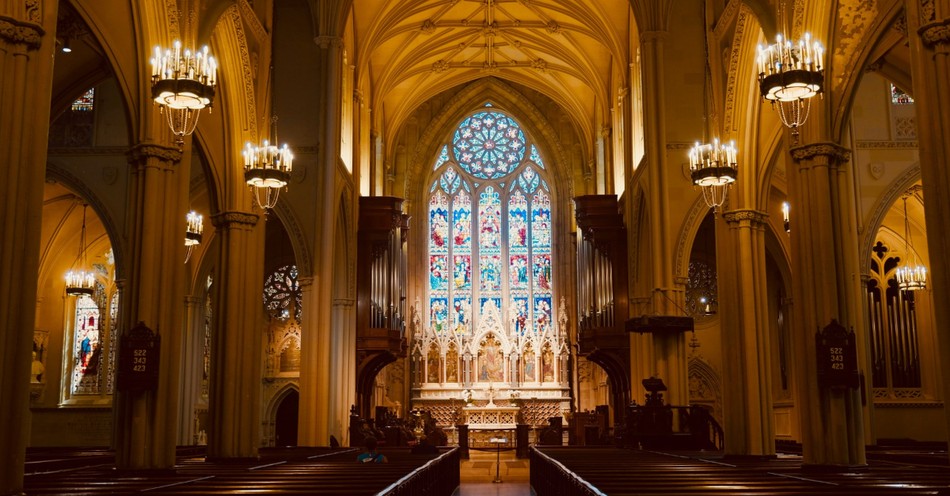Do all church buildings face east? Does this matter? Why have some Christian denominations constructed their church buildings so that the doors face east?
Why Do Some Churches Face East?
The denominational practice of orienting worship toward the east began as a custom following the Jewish practice of praying toward the temple in Jerusalem. Even though Daniel had to face west toward Jerusalem when he prayed, those who follow the Jewish custom use Daniel 6:11 as their example. When Daniel faced exile in Babylon, he made sure his windows were open toward Jerusalem as he prayed and thanked God each day. After the Romans destroyed the Temple in AD 70, some Jews were encouraged to construct their synagogues with east-facing entrances to mimic the Jerusalem Temple (both Solomon’s and the second temple faced east).
Jewish tradition followed with those outside Israel praying toward the country and those inside Israel praying toward Jerusalem. Jews inside Jerusalem were to pray toward the Temple, and those inside the Temple were to pray toward the Holy of Holies.
The temple’s eastward entrance follows the LORD’s instructions in Exodus 27:9-18 and Numbers 2:1-34. Ezekiel 43:1-5 and 44:1-5 add further credence to the reason for the eastward-facing temple entrance.
Ezekiel’s visions include the Lord’s glory departing the Temple (Ezekiel 10:1-22; 11:1-13; cf. Exodus 40:34-35; 1 Kings 8:1-11).
In Ezekiel 43:2, however, we read about a future reappearance of the Lord’s glory returning from the east, “And behold, the glory of the God of Israel came from the way of the east. His voice was like the sound of many waters; and the earth shone with His glory.” Verses 4-5 add, “And the glory of the LORD came into the temple by way of the gate which faces toward the east. The Spirit lifted me up and brought me into the inner court; and behold, the glory of the LORD filled the temple.”
And so, the Jews look for their Messiah to come from the east and fill the temple with His glory (for them, the not-as-yet-constructed third temple). Jewish temples continue to have an eastern-facing entrance.
An interesting side note is that pagan cultures often worshipped a sun god and faced east to worship it. Having an eastern-oriented entrance caused the worshipers to face away from the sunrise as they entered the temple. Therefore, they could not be mistaken for pagan worshipers.
The building orientation for early Christian gatherings was inconsequential, yet following the religion’s fourth-century legalization, customary practices emerged which differed between Eastern and Western Christian church buildings.
Examples of Eastern-Facing Churches
Not all church buildings face east, but some still hold to a mandate toward eastern orientation.
- Many Eastern Orthodox churches are built to face east while all the church buildings of the Eastern Coptic church are designed to face east (St. Mark’s in Alexandria is one). Buildings obtained from other Christian denominations are even remodeled to fit the eastern orientation.
- The Sagrada Familia is Barcelona’s unique Catholic church, standing alone in its architectural style. Its magnificent exterior and its eastern-facing Nativity façade, dedicated to the birth of Jesus, are noteworthy. Its illumination at dawn symbolizes hope.
- In Brittany, France, the Medieval Quimper Cathedral demonstrates an eastern oriented church design, bending slightly to accommodate its location to avoid a former swamp.
Architectural styles vary amongst Protestant churches, but they don’t set Eastern orientation as an obligation.
These churches have some common characteristics:
- The services/sermons are emphasized above the building’s orientation. The message takes precedence over the setting.
- Most are light-filled through either plain or stained-glass windows. More contemporary buildings are windowless with greater interior lighting for the platform area.
- Some are plain, others are decorative.
- The pulpit and baptism area are highlighted
Biblical Basis for East-Facing Churches
Outside the God-given directions for the Jewish temple found in the Old Testament, churches have no command to orient their buildings in an easterly manner.
During the first century soon after Jesus ascended, believers met in house churches. We can see this exemplified in the book of Acts (Acts 1:13; 2:2, 46; 12:12) as believers met for instruction, fellowship, and prayer. Looking at Romans 16, we see Paul addressed at least five different house churches.
While a few churches adhere to the Old Testament tradition of facing east, the majority of Christian churches today prioritize convenience and location over specific orientation. To most, the central focus of worshipping the Lord supersedes a tradition of building orientation.
Why Did Early Christians Choose an Eastward Orientation for Churches?
The selection of church building orientation was symbolic, not biblically mandated. In Rome, the earliest Christian churches were constructed with the entrance facing east, similar to the Jewish temple in Jerusalem, until the 8th or 9th century when a different orientation was embraced. The ancient Roman tradition of positioning the altar in the west and the entrance in the east was observed in some districts under Frankish control until the 11th century, as corroborated by the Petershausen Abbey (Konstanz), the Bamberg Cathedral, the Augsburg Cathedral, the Regensburg Cathedral, and Hildesheim Cathedral in modern-day Germany.
The leading reasons for east-facing church entrances include:
1. Scripture- The Scriptures cited are Zechariah 14:4-8 and Matthew 24:27, which reads, “For as the lightning comes from the east and flashes to the west, so also will the coming of the Son of Man be.”
2. Symbolic- The east represents His glory as departed and returned (see Ezekiel 43-44).
3. Worship- Facing east is supposed to represent a visual longing for Christ’s second coming and the new heavens and earth.
When Christianity began to take root after Christ’s ascension, some early Christians prayed toward the Mount of Olives, which sits east of Jerusalem. They saw the Mount as a key end times location where Christ would return and spread “living waters” to the east and to the west (Zechariah 14:4-8; Matthew 24:27).
The practice of eastern-directed prayer continues, although not as a mandated practice in Christian churches. With eager anticipation, however, many Christians continue to look for Christ’s return to come from the east.
Does Church Orientation Impact Worship?
Adhering to the traditions of the church fathers often fosters a reverent approach to worship. A Christian experiences holy wonder entering a building whose structure and layout are dedicated solely to worship. Reflecting on God’s instructions for the temples and David’s prayers toward Jerusalem during exile helps believers value the effort put into aligning oneself for worship of our holy God.
That awe, however, mustn’t manifest itself into rote or legalistic expectations for all church structures to adhere to the same orientation. The awe also must always be directed to the Lord God and not an edifice.
Healthy contemporary churches buy or construct their buildings based upon ministry and/or growth needs (and much prayer). Practicing good stewardship means fitting into available communities as the Lord allows. If it so happens that the building’s entrance faces east, it’s a great opportunity for the congregation to learn some church history.
Wise believers know the heart of the matter is the matter of the heart (Jeremiah 17:9). You can be in the grandest, most ornate church building and still lack a true heart of worship. Jesus said, “But the hour is coming, and now is, when the true worshipers will worship the Father in spirit and truth; for the Father is seeking such to worship Him. God is Spirit, and those who worship Him must worship in spirit and truth” (John 4:23-24).
When we enter into worship with our brothers and sisters, may we center our hearts and attention on Christ’s glory.
Photo credit: ©Unsplash/JohnyVino




_639003522088907085.jpg)